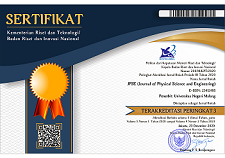Kajian Electronic Structure pada ZnO Nanoparticles Menggunakan Ionization Energy-Tight Binding Model
Abstract
Zinc oxide (ZnO) nanoparticles have been investigated intensively related to their applications such as in optical band gap energy for semiconductor application. In general, the characterization of band gap energy of the ZnO nanoparticles has been carried out using UV-Vis spectroscopy. In this work, ionization energy-tight binding model was developed to analyze the optical binding energy of the ZnO nanoparticles. The primary technique of the electronic structure calculation was an analytical calculation of overlap integral of 2p orbital from O and 3d orbital from Zn. The result of the calculation presents that the maximum bandgap energy of ZnO particles is about of 4.4 eV. This result is almost similar to band gap energy of the ZnO nanoparticles showing by experimental result.
Keywords
Full Text:
PDF (Bahasa Indonesia)References
M. Kahouli, A. Barhoumi, A. Bouzid, A. Al-Hajry, and S. Guermazi, “Structural and optical properties of ZnO nanoparticles prepared by direct precipitation method,” Superlattices Microstruct., vol. 85, pp. 7–23, Sep. 2015.
D. A. Keszler, “Borates for optical frequency conversion,” Curr. Opin. Solid State Mater. Sci., vol. 1, no. 2, pp. 204–211, Apr. 1996.
M. Cardona and P. Y. Yu, “Optical Properties of Semiconductors,” in Comprehensive Semiconductor Science and Technology, Elsevier, 2011, pp. 125–195.
M. N. Hoda, 3 rd International Conference on Computing for Sustainable Global Development:(16th-18th March, 2016). Piscataway, NJ: IEEE, 2016.
S. Bhatia, N. Verma, and R. K. Bedi, “Optical application of Er-doped ZnO nanoparticles for photodegradation of direct red - 31 dye,” Opt. Mater., vol. 62, pp. 392–398, Dec. 2016.
N. Srinatha, P. Raghu, H. M. Mahesh, and B. Angadi, “Spin-coated Al-doped ZnO thin films for optical applications: Structural, micro-structural, optical and luminescence studies,” J. Alloys Compd., vol. 722, pp. 888–895, Oct. 2017.
W. Hu, Z. Li, and J. Yang, “Electronic and optical properties of graphene and graphitic ZnO nanocomposite structures,” J. Chem. Phys., vol. 138, no. 12, p. 124706, Mar. 2013.
L. Xu, G. Zheng, Y. Liu, J. Su, W. Kuang, and W. Rao, “The optical properties of Ag/ZnO nanocomposite thin films with different thickness,” Opt. - Int. J. Light Electron Opt., vol. 147, pp. 6–13, Oct. 2017.
C. V. Reddy, B. Babu, and J. Shim, “Synthesis, optical properties and efficient photocatalytic activity of CdO/ZnO hybrid nanocomposite,” J. Phys. Chem. Solids, vol. 112, pp. 20–28, Jan. 2018.
M. Alam, N. M. Alandis, A. A. Ansari, and M. R. Shaik, “Optical and Electrical Studies of Polyaniline/ZnO Nanocomposite,” J. Nanomater., vol. 2013, pp. 1–5, 2013.
M. Tanveer, A. Habib, and M. B. Khan, “Structural and optical properties of electrospun ZnO nanofibres applied to P3HT:PCBM organic photovoltaic devices,” J. Exp. Nanosci., vol. 10, no. 8, pp. 640–650, May 2015.
P. Viswanathamurthi, N. Bhattarai, H. Y. Kim, and D. R. Lee, “The photoluminescence properties of zinc oxide nanofibres prepared by electrospinning,” Nanotechnology, vol. 15, no. 3, pp. 320–323, Mar. 2004.
J. Fan, T. Li, and H. Heng, “Hydrothermal growth and optical properties of ZnO nanoflowers,”Mater. Res. Express, vol. 1, no. 4, p. 045024, Nov. 2014.
R. A. Wahyuono et al., “ZnO nanoflowers-based photoanodes: aqueous chemical synthesis, microstructure and optical properties,” Open Chem., vol. 14, no. 1, Jan. 2016.
X. Liu et al., “Growth mechanism, optical and photocatalytic properties of ZnO nanorods@nanoflowers (quantum dots) hybrid nanostructures,” Ceram. Int., vol. 41, no. 9, pp. 12258–12266, Nov. 2015.
J. Jiménez Reinosa, P. Leret, C. M. Álvarez-Docio, A. del Campo, and J. F. Fernández, “Enhancement of UV absorption behavior in ZnO–TiO2 composites,” Bol. Soc. Esp. Cerámica Vidr., vol. 55, no. 2, pp. 55–62, Mar. 2016.
A. Zak, A. Hashim, and M. Darroudi, “Optical properties of ZnO/BaCO3 nanocomposites in UV and visible regions,” Nanoscale Res. Lett., vol. 9, no. 1, p. 399, 2014.
Y. Liu et al., “Synergistic Effect of Surface Plasmonic particles and Surface Passivation layer on ZnO Nanorods Array for Improved Photoelectrochemical Water Splitting,” Sci. Rep., vol. 6, no. 1, Sep. 2016.
K.-F. Lin, C.-J. Pan, and W.-F. Hsieh, “Calculations of electronic structure and density of states in the wurtzite structure of Zn1−xMgxO alloys using sp3 semi-empirical tight-binding model,”Appl. Phys. A, vol. 94, no. 1, pp. 167–171, Jan. 2009.
C. Fisker and T. G. Pedersen, “Density-functional based tight-binding modelling of ZnO structures,” Phys. Status Solidi B, vol. 246, no. 2, pp. 354–360, Feb. 2009.
A. Kobayashi, O. F. Sankey, S. M. Volz, and J. D. Dow, “Semiempirical tight-binding band structures of wurtzite semiconductors: AlN, CdS, CdSe, ZnS, and ZnO,” Phys. Rev. B, vol. 28, no. 2, pp. 935–945, Jul. 1983.
J. Linderberg and Y. Öhrn, “Tight-binding model for the energy bands in solids,” Chem. Phys. Lett., vol. 3, no. 3, pp. 119–121, Mar. 1969.
Y. B. Malykhanov and M. V. Gorshunov, “Energies of Atoms and Ions Calculated by the Hartree–Fock Method,” J. Appl. Spectrosc., vol. 80, no. 5, pp. 631–636, Nov. 2013.
Collaboration: Authors and editors of the volumes III/17B-22A-41B, “Zinc oxide (ZnO) crystal structure, lattice parameters,” in II-VI and I-VII Compounds; Semimagnetic Compounds, vol. 41B, O. Madelung, U. Rössler, and M. Schulz, Eds. Berlin/Heidelberg: Springer-Verlag, 1999, pp. 1–5.
S. Fraga, K. M. S. Saxena, and J. Karwowski, “Hartree–Fock Ionization Potentials of Atoms,”Can. J. Phys., vol. 51, no. 19, pp. 2063–2074, Oct. 1973.
S. Talam, S. R. Karumuri, and N. Gunnam, “Synthesis, Characterization, and Spectroscopic Properties of ZnO Nanoparticles,” ISRN Nanotechnol., vol. 2012, pp. 1–6, 2012.
Copyright (c) 2019 Yuda Prima Hardianto

This work is licensed under a Creative Commons Attribution-NonCommercial-ShareAlike 4.0 International License.
This work is licensed under a Creative Commons Attribution-ShareAlike 4.0 International License



















